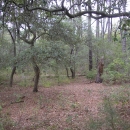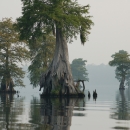About Us
The Coastal North Carolina National Wildlife Refuges Gateway Visitor Center was a long-time dream for the US Fish and Wildlife Service and many refuge and wildlife supporters on the Outer Banks and in eastern North Carolina. The building opened in 2012 and is LEED (Leadership in Energy & Environmental Design) certified and energy-efficient, with features including solar panels, low-volume toilets, and a highly energy-efficient heating and cooling system. The visitor center houses a 130-seat auditorium, an educational classroom, and outdoor exhibits. The pollinator garden in front of the refuge is filled with native North Carolina plants that support pollinators.
In addition to receiving the public, the building houses the administrative offices for Alligator River and Pea Island National Wildlife Refuges.
Our Mission
The U.S. Fish and Wildlife Service is the primary federal agency responsible for the conservation, protection, and enhancement of the Nation’s fish and wildlife populations and their habitats. Although the Service shares some conservation responsibilities with other federal, state, tribal, local, and private entities, it has specific trustee obligations for migratory birds, threatened and endangered species, anadromous fish, and certain marine mammals. In addition, the Service administers a national network of lands and waters for the management and protection of these resources. As part of its mission, the Service manages more than 540 national wildlife refuges covering a total of more than 93 million acres. These areas comprise the National Wildlife Refuge System, the world’s largest collection of lands and waters specifically managed for fish and wildlife. The majority of these lands, 77 million acres, lie in Alaska. The remaining 16 million acres are spread across the other 49 states and several island territories.
The mission of the National Wildlife Refuge System, as defined by the National Wildlife Refuge System Improvement Act of 1997, is:
"... to administer a national network of lands and waters for the conservation, management, and where appropriate, restoration of the fish, wildlife and plant resources and their habitats within the United States for the benefit of present and future generations of Americans."
Other Facilities in this Complex
The Gateway Visitor Center serves as an introduction to the Coastal North Carolina National Wildlife Refuge Complex, as well as two other refuges and a national fish hatchery in the area: Great Dismal Swamp NWR, Back Bay National Wildlife Refuge, and Edenton National Fish Hatchery. A National Wildlife Refuge Complex is an administrative grouping of two or more refuges, wildlife management areas or other refuge conservation areas that are primarily managed from a central office location. Refuges are grouped into a complex structure structure
Something temporarily or permanently constructed, built, or placed; and constructed of natural or manufactured parts including, but not limited to, a building, shed, cabin, porch, bridge, walkway, stair steps, sign, landing, platform, dock, rack, fence, telecommunication device, antennae, fish cleaning table, satellite dish/mount, or well head.
Learn more about structure because they occur in a similar ecological region, such as a watershed or specific habitat type, and have a related purpose and management needs.
There are 9 national wildlife refuges in the Coastal North Carolina National Wildlife Refuges Complex. The Project Leader for the Complex supervises the Refuge Managers who are responsible for managing these refuges. However, there are five distinct and separate administrative offices. Alligator River and Pea Island National Wildlife Refuges are administered from the Alligator River National Wildlife Refuge Headquarters in Manteo, NC. An administrative office at the Mackay Island National Wildlife Refuge Headquarters in Knotts Island, NC manages both Mackay Island and Currituck National Wildlife Refuges. An office at Mattamuskeet National Wildlife Refuge administers Mattamuskeet, Swanquarter, and Cedar Island National Wildlife Refuges. Pocosin Lakes National Wildlife Refuge, Roanoke River National Wildlife Refuge, Great Dismal Swamp National Wildlife Refuge, Back Bay National Wildlife Refuge, and Edenton National Fish Hatchery each have separate administrative offices.
All of the Coastal North Carolina National Wildlife Refuges, Great Dismal Swamp National Wildlife Refuge, Back Bay National Wildlife Refuge, and Edenton National Fish Hatchery are open to public visits for nature-based recreational enjoyment. Priority public uses are hunting, fishing, wildlife observation, wildlife photography, environmental education, and interpretation.






